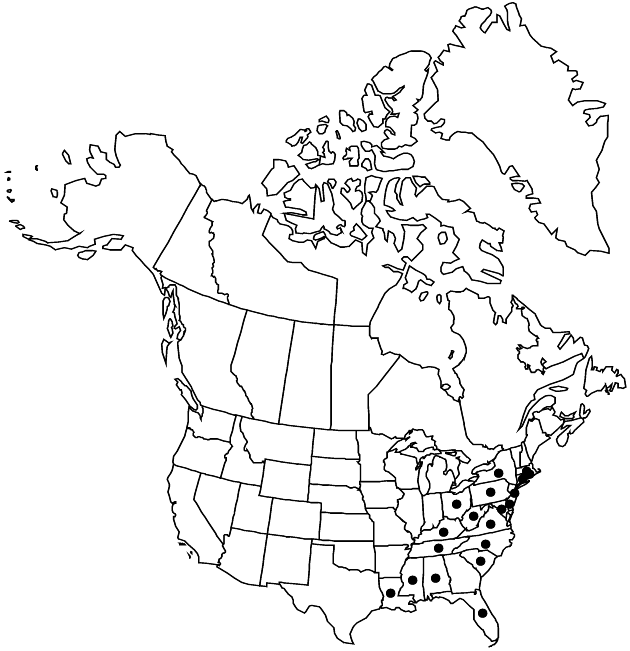Difference between revisions of "Ageratina aromatica"
Hist. Nat. Vég. 10: 286. 1841.
FNA>Volume Importer |
imported>Volume Importer |
||
| (5 intermediate revisions by 2 users not shown) | |||
| Line 8: | Line 8: | ||
}} | }} | ||
|common_names=Small-leaved white snakeroot | |common_names=Small-leaved white snakeroot | ||
| − | |basionyms={{Treatment/ID/ | + | |special_status={{Treatment/ID/Special_status |
| + | |code=E | ||
| + | |label=Endemic | ||
| + | }} | ||
| + | |basionyms={{Treatment/ID/Basionym | ||
|name=Eupatorium aromaticum | |name=Eupatorium aromaticum | ||
|authority=Linnaeus | |authority=Linnaeus | ||
| + | |rank=species | ||
| + | |publication_title=Sp. Pl. | ||
| + | |publication_place=2: 839. 1753 | ||
}} | }} | ||
|synonyms={{Treatment/ID/Synonym | |synonyms={{Treatment/ID/Synonym | ||
|name=Eupatorium latidens | |name=Eupatorium latidens | ||
|authority=Small | |authority=Small | ||
| + | |rank=species | ||
}} | }} | ||
|hierarchy=Asteraceae;Asteraceae tribe Eupatorieae;Ageratina;Ageratina aromatica | |hierarchy=Asteraceae;Asteraceae tribe Eupatorieae;Ageratina;Ageratina aromatica | ||
| Line 39: | Line 47: | ||
-->{{#Taxon: | -->{{#Taxon: | ||
name=Ageratina aromatica | name=Ageratina aromatica | ||
| − | |||
|authority=(Linnaeus) Spach | |authority=(Linnaeus) Spach | ||
|rank=species | |rank=species | ||
| Line 53: | Line 60: | ||
|publication title=Hist. Nat. Vég. | |publication title=Hist. Nat. Vég. | ||
|publication year=1841 | |publication year=1841 | ||
| − | |special status= | + | |special status=Endemic |
| − | |source xml=https:// | + | |source xml=https://bitbucket.org/aafc-mbb/fna-data-curation/src/2e0870ddd59836b60bcf96646a41e87ea5a5943a/coarse_grained_fna_xml/V19-20-21/V21_1395.xml |
|tribe=Asteraceae tribe Eupatorieae | |tribe=Asteraceae tribe Eupatorieae | ||
|genus=Ageratina | |genus=Ageratina | ||
Latest revision as of 20:10, 5 November 2020
Perennials, 30–80(–100) cm. Stems erect, villous-puberulent. Leaves opposite; petioles 1–8(–12) mm; blades narrowly to broadly deltate to nearly ovate or lanceolate, 2–7(–9) × 1.5–4 cm, (usually subcoriaceous) bases rounded or truncate to barely cuneate or subcordate, margins usually crenate, sometimes crenate-serrate to dentate or subentire, apices acute to obtuse, faces minutely pilose. Heads clustered. Peduncles 2–9 mm, densely and closely puberulent. Involucres 3.5–5 mm. Phyllaries: apices acute, abaxial faces puberulent to villous-puberulent. Corollas white, lobes sparsely villous. Cypselae usually glabrous or sparsely puberulent (near apices), rarely hirtellous on angles. 2n = 34.
Phenology: Flowering late Aug–Oct(–Nov).
Habitat: Sandy soils, burned pinelands, turkey oak sand ridges, pine-oak and oak-hickory upland woods, old fields, roadsides, fencerows, moist sites
Elevation: 100–900 m
Distribution

Ala., Conn., Del., Fla., Ky., La., Md., Mass., Miss., N.J., N.Y., N.C., Ohio, Pa., R.I., S.C., Tenn., Va., W.Va.
Discussion
Intergrades (probable hybrids) between Ageratina aromatica and A. altissima were identified by A. F. Clewell and J. W. Wooten (1971) over a broad area of their sympatry. They also found intergrades between A. aromatica and A. jucunda where their ranges meet.
Selected References
None.